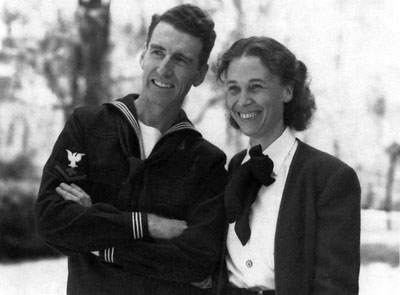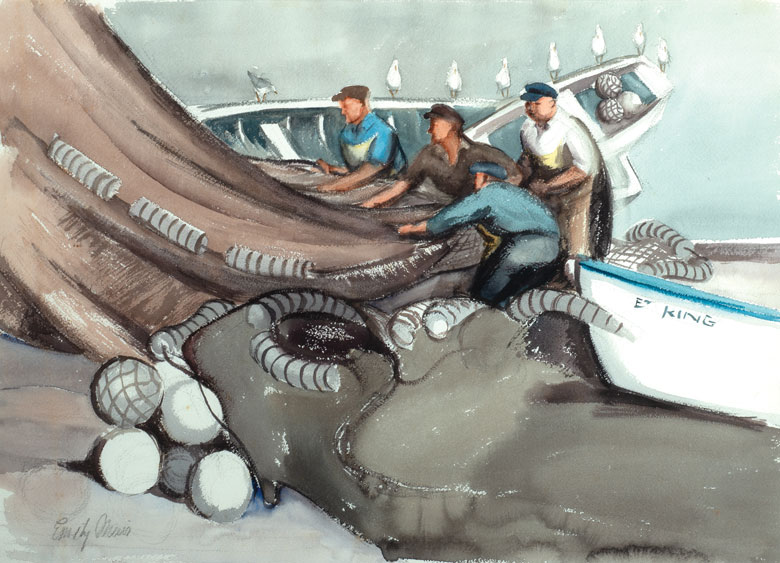In Emily Muir’s watercolor “Flaking the Purse Seine,” painted around 1940, four fishermen in caps lean into their work, gathering the nets in preparation for taking to the sea.
“In the days when nets were made from natural fibers,” Ben Fuller, maritime historian notes, “you needed to clean and dry them after use,” adding that they often were submerged in vats of salt preservative to keep them from rotting.
Muir renders the fine-mesh nets in a gray wash that is a shade lighter than the ledge in the foreground. Lines of cork floats snake around the scene. Three boats, one of them named E. King, are pulled up on the shore. There’s a clutch of what are probably glass buoys and an almost comical line of white gulls looking on at the laboring men.
They were taken by the working harbor with its fishermen and the stonecutters…
When Muir (1904-2003) and her husband, sculptor William Muir (1902-1964) moved to Stonington in 1939, the town had an active sardine cannery. They were both taken by the working harbor with its fishermen and the stonecutters who worked in the island quarries and they honored them in their art. Emily’s stone mosaic, “Stonington,” is one of the stars of the Farnsworth Art Museum collection while William’s bronze “Stonecutter” is a landmark on the town’s waterfront.
In her 99 years Emily Muir lived a kind of ultimate modern American life span that included five wars, the Great Depression, and 9/11.
Her autobiography, The Time of My Life, published by the Island Institute in 2002, takes the reader from her birth in Chicago through early years in New York City; a short stint at Vassar (she was asked to leave after wearing men’s knickers and shoes to a friend’s graduation ceremony); meeting her husband at the Art Students League (her classmates included Ludwig Bemelmans of the Madeleine children’s books fame and Isamu Noguchi, who become one of the most important sculptors of the 20th century); working at Macy’s department store; travels and adventures abroad, including trips to the West Indies, South America, Russia, and Scandinavia; and her life in Maine.

Muir’s history includes her husband’s stint in the Navy during World War II. Enlisting at age 40, he started off in Portsmouth, N.H., then went to the Brunswick Naval Air Station and finally to Mare Island Naval Shipyard in Vallejo, Calif., where he worked in a hospital for amputees and victims of shell shock.
Emily’s parents were so impressed with his enlisting they gave him Russ Island, part of the archipelago that lies between Stonington and Isle au Haut (the Chewonki Foundation became the “proud owner” of the island in 2006).
After hosting Margaret Chase Smith at her parents’ home in Stonington, Muir was asked to paint the senator’s official portrait (when the Maine Arts Commission asked for 23 changes, the artist responded, “Go do it yourself”). As a result of that commission, she was appointed to the Commission of Fine Arts under Eisenhower and then Nixon; it later became the NEA. The only woman on the commission, she was pretty much ignored. At one point she suggested that a certain percentage of the cost of any new government buildings be reserved to enrich and beautify them. Her suggestion fell on deaf ears but she liked to think it may have somehow inspired the percent for art program, which has been so successful in Maine.
The Muirs were responsible for finding land for the Haystack Mountain School of Crafts when it decided to move from Liberty in 1960. The building of the Deer Isle bridge in 1939, of which Emily didn’t really approve, helped in the decision to move the school.
In addition to being a painter, Muir was a self-taught architect and designer, as well as an author, lecturer, and conservationist. Island Institute founder Philip Conkling referred to her as a “practical visionary,” protecting islands from development. The Muirs’ papers are in the Smithsonian Archives of American Art, donated by Emily in 1993 and 1996.
Muir was a founding member of the Island Institute and worked with the institute, the Nature Conservancy, Maine Coast Heritage Trust, and the Stonington Conservation Commission, among other environmental organizations, to preserve land in Maine.
She and her husband were also great community people. Among other things, they invited local kids to come and swim in a saltwater pool they constructed on the shore near their house. Some of them learned to swim for the first time.
Courthouse Gallery Fine Art in Ellsworth represents Emily Muir’s estate. Carl Little provided the introduction to The Prints of Siri Beckman (Down East Books).





